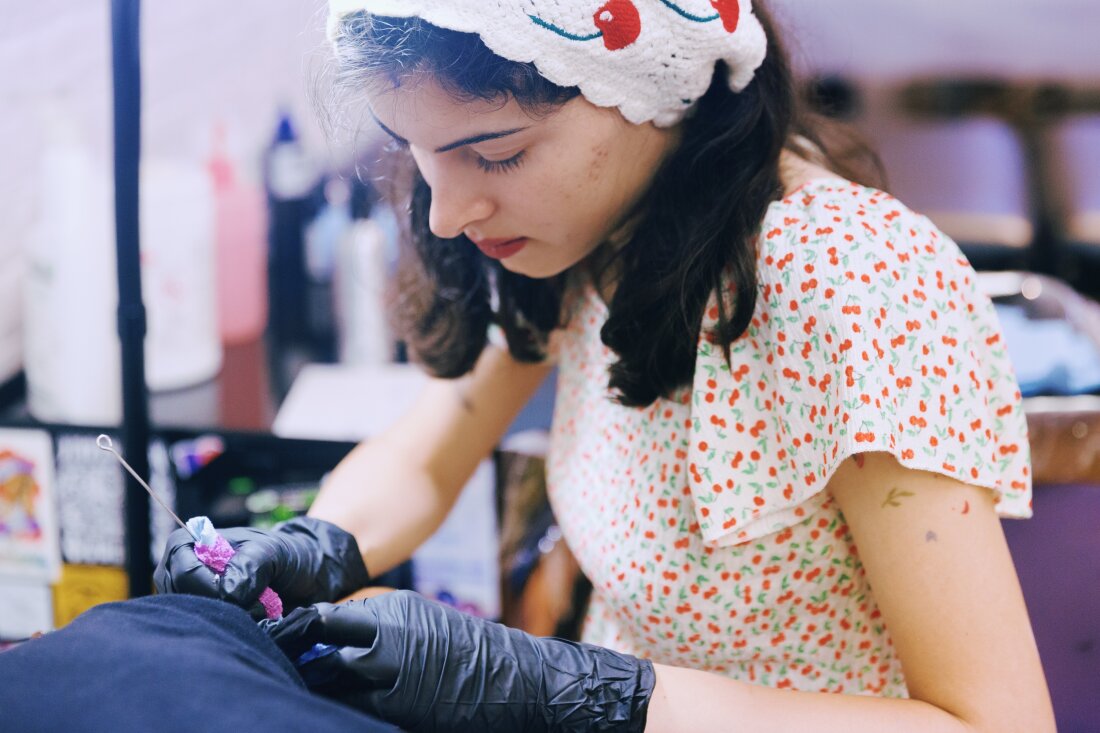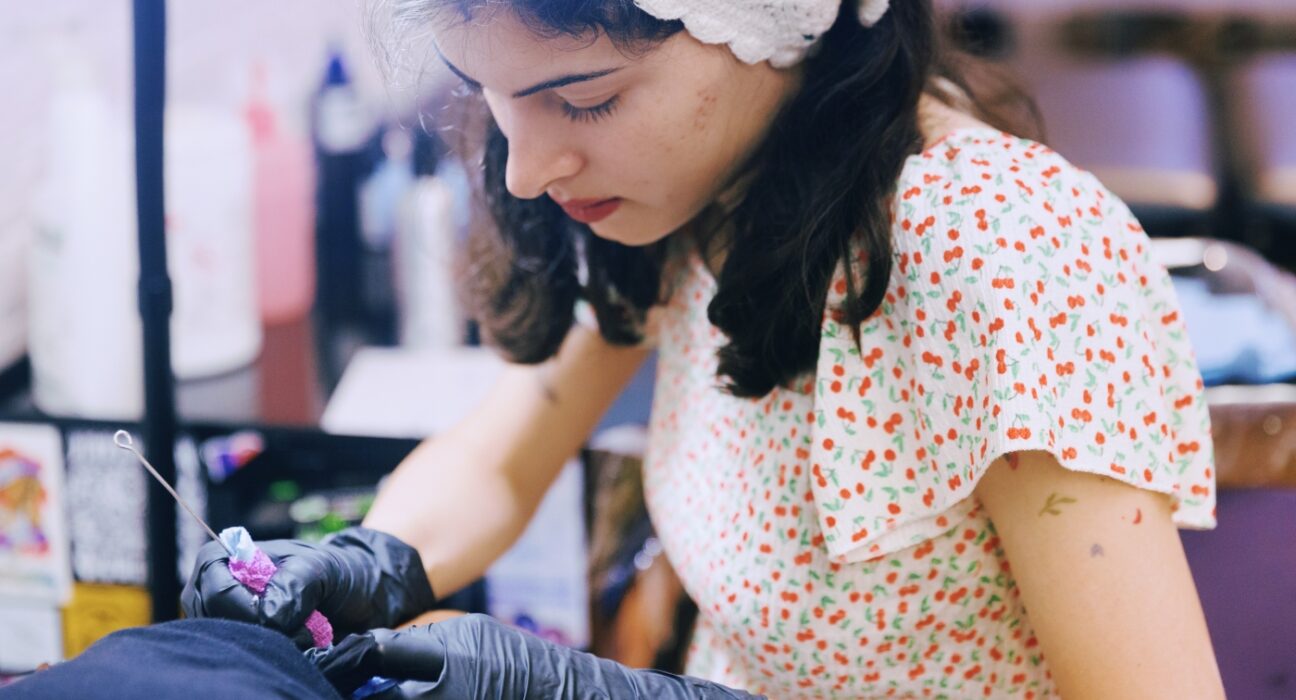
Abby Ingwersen, a guest artist at Nice Try Tattoo, works on a client using the stick and poke method.
Mengwen Cao for NPR
hide caption
toggle caption
Mengwen Cao for NPR
For purveyors of an artform that’s famously permanent, tattoo artists sure like to switch things up.
In studios and shops around the world, younger artists are challenging the traditional ways of running a business and poking ink into skin.
From independent collectives to a revival of the so-called “stick and poke” tattoo, a new generation is leaving its mark.
A new studio structure
In a typical walk-in tattoo shop, there is an owner, some contracted artists and maybe an apprentice. The artists pay a percentage of their earnings to the owner in return for expertise, a place to work and a storefront to attract clients.
But some artists are forging ahead with a new, non-hierarchical vision: the independent studio, where the idea is to cut out the middle-man.
That’s where you will find Ella Sklaw, one of the five artists who works out of Nice Try Tattoo — a collaboratively-owned and operated tattoo studio they started three years ago with a friend in Brooklyn, New York.
The members of Nice Try Tattoo, which includes (clockwise from top left) Cierson Zambo, Sydney Kleinrock, Ella Sklaw, Sara Sremac and Lu Walstad.
Mengwen Cao for NPR
hide caption
toggle caption
Mengwen Cao for NPR
Ella Sklaw talks through the process with their client, Maddie Dennis-Yates.
Mengwen Cao for NPR
hide caption
toggle caption
Mengwen Cao for NPR
From the outside, Nice Try Tattoo is an unassuming warehouse. But once you enter, you’re met with comfy couches, walls plastered with thank you notes, and a wooden dining table in the back.
“We visually decorate the entire shop together,” Sklaw says. “We try to keep it super warm and super inviting. I think we really go for this idea that you should have stuff to look at while you’re getting a tattoo, because it hurts.”
For Maddie Dennis-Yates, one of Sklaw’s clients on a recent summer day, those touches are appreciated.
“There’s been a real shift in the vibe of tattoo studios lately,” Dennis-Yates says. “Even just having it in a building like this, it’s got this certain coziness to it. Like, you have to go find it somewhere, you can’t just stumble in off the street.”
For an array of reasons, the pandemic contributed to the rise of independent studios — some artists took up the skill during lockdown, while some clients found extra money or the confidence to get inked. And while there isn’t complete data on the number of independent studios versus traditional shops, the industry as a whole grew a steady 2.5% a year from 2018-23, according to research from IBISWorld.
The move towards independent work models is a symptom of something larger, especially for artists and creatives who have been the most historically exploited, according to Trebor Scholz, a New School professor who researches cooperative entrepreneurship.
“We have seen the increase during the pandemic, but this is something that is part of a much longer shift in the way work has performed over the past 50 years really, and these kind of non-standard work arrangements,” he said. “I don’t think the clock will be turned back on them.”
A “stick and poke” revival
Along with a shift in the business model there are also evolving styles and tastes — both from customers and artists.
Some artists at Nice Try Tattoo have left the machine behind and rely on a singular needle to etch their designs. It’s a method often called “stick and poke” or “hand poke.”
Nicole Monde works out of a private studio in Brooklyn.
Mengwen Cao for NPR
hide caption
toggle caption
Mengwen Cao for NPR
“I just take the needle and I just put it in my hand and then I just poke the design dot by dot,” says Nicole Monde, a hand poke artist who shares a private studio space in Brooklyn. “It’s very similar to machine in that it’s going the same depth, I’m using the same ink, same supplies, same needles and everything, but I’m just taking the machine out of it.”
Hand poke tattoos can conjure up images of college dorm rooms or DIY mishaps, and Monde acknowledges it’s not always seen as legitimate.
Monde puts together a tattoo design.
Mengwen Cao for NPR
hide caption
toggle caption
Mengwen Cao for NPR
“I think a lot of people don’t see it as a valid form of tattooing because the industry standard for so long has been using a machine. But I like to point out the fact that before electricity existed, this is how all tattoos were being done,” she says.
Some clients, like E Barnick, prefer hand poke tattoos for the overall experience.
“It’s totally different,” Barnick says. “I mean, it doesn’t hurt nearly as much and it’s also just a lot more intimate to have somebody hand poking.”
Still, some artists make the case that there are benefits to the traditional shop model that are lost when artists work out of independent studios and trade in different approaches.
“They’re missing out on the grander scale of experience and I think it’s harder to advance as an artist. I think you need that interaction with the average daily wacko wandering in off the street,” says Mehai Bakaty, who owned Fineline Tattoo in Manhattan until it was forced to close due to rising costs and the pandemic lockdowns.
Still, Bakaty now works from an independent studio as well, and says it takes him back to the 1990s when New York tattoo shops used to all operate under the radar because their operations were illegal and there were concerns about AIDS transmission.
“Sort of underground, clandestine, appointment-only, word of mouth, no advertising, no storefronts,” he says.
It’s not lost on Sklaw, from Nice Try Tattoo, that their collective studio model has come full circle back to these same ideas: word of mouth. No storefronts. No walk-ins.
Sklaw works on a client.
Mengwen Cao for NPR
hide caption
toggle caption
Mengwen Cao for NPR
Artist Sara Sremac show her client E Barnick their new tattoo.
Mengwen Cao for NPR
hide caption
toggle caption
Mengwen Cao for NPR
“We kind of exist in the legacy of that alternative space,” Sklaw says.
These days, whether clients choose a machine or hand-poked tattoo, at an indie studio or a shop, the goal is the same: distinctive, meaningful, permanent art.
“Tattoos, I mean, cross-culturally, were always something to be extremely proud of,” says Lars Krutak, a tattoo anthropologist. “Because we’re talking primarily these … identify you as a member of a community.”
So when clients leave Nice Try Tattoo or a traditional shop, they aren’t just coming home with a new tattoo. The marking is a symbol of a community much larger than a singular artist or a singular needle.

